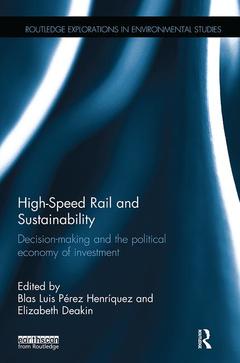High-Speed Rail and Sustainability Decision-making and the political economy of investment Routledge Explorations in Environmental Studies Series
Coordonnateurs : Pérez Henríquez Blas Luis, Deakin Elizabeth

High speed rail (HSR) is being touted as a strategic investment for connecting people across regions, while also fostering prosperity and smart urban growth. However, as its popularity increases, its implementation has become contentious with various parties contesting the validity of socioeconomic and environmental objectives put forward as justification for investment.
High Speed Rail and Sustainability explores the environmental, economic and social effects of developing a HSR system, presenting new evaluations of the proposed system in California in the US as well as lessons from international experience. Drawing upon the accumulated experience from past HSR system development around the world, leading experts present a diverse set of perspectives as well as diverse contexts of implementation. Assessments of the California case as well as cases from Japan, France, Germany, Italy, Spain, Taiwan, China, and the UK show how governments and stakeholders have bridged the gap between the vision and the realities of connecting metropolitan regions through HSR.
This is a valuable resource for academics, researchers and policy-makers in the areas of urban planning, civil engineering, transportation and environmental design.
Preface
Section I – What have we learned so far from high-speed rail systems around the world?
1. Introduction to HSR
2. Realizing the Potential of HSR: The United Kingdom Experience
3. The Shinkansen and its Impacts
4. Where High-Speed Rail is Relevant: The French Case Study
5. Evidence from the Italian High-Speed Rail Market: Competition between Modes and Between HSR Operators
6. High-Speed Rail in Spain: Territorial Management and Sustainable Urban Development
7. High-Speed Rail and Air Travel Complementarity: The Case of Germany
8. Taiwan’s HSR and the Financial Crises of the Taiwan High Speed Rail Corporation
9. Study on the Influence of Site Selection of High-speed Railway Stations on Travel Efficiency—An example of Shanghai Hongqiao Hub Pan Haixiao, Ye Song and Chen Minglei
10. Forecasting for High Speed Rail: An Operator’s Perspective on Risk Reduction through Informed Use of Forecasting
11. Enhancing the Cost-Benefit Analysis of High-Speed Rail
Section II - California’s Bold HSR Adventure: Transforming Transport Culture in America?
12. Background on HSR in California
13. High-Speed Rail and Smart Growth in California
14. Policy Process, Institutions, and the California High-Speed Rail Project: Towards Sustainable Transportation and Smart Growth?
15. High-Speed Rail and Economic Development: Business Agglomerations and Policy Implications
16. Environmental Impact of High-Speed Rail in California
17. Uncertainties in the Life Cycle Assessment of High-speed Rail’s Energy and Environmental Impacts
18. Equity Analysis of California High-Speed Rail
19. NIMBY Reactions to HSR: Conflicts over the Proposed Right of Way
20. High-Speed Rail Stations as Transportation Nodes and Places: Lessons for California
21. Sustainable Mobility: Towards Integrated Transport Systems in 2050
Blas Luis Pérez Henriquez is the Founding Director of the California - Global Energy, Water & Infrastructure Innovation Initiative, Stanford University, USA.
Elizabeth Deakin is Professor Emerita of City and Regional Planning at the University of California, Berkeley, USA.
Date de parution : 06-2018
15.6x23.4 cm
Date de parution : 12-2016
15.6x23.4 cm
Thèmes de High-Speed Rail and Sustainability :
Mots-clés :
HSR Station; HSR system; High Speed Rail System; Climate Change; HSR Project; economic development; HSR Service; Environmental economics; CAHSR; Environmental policy; HSR Line; Environmental studies; High Speed Rail Network; Sustainability; Northeast Corridor; Sustainable development; Public Private Partnerships; smart growth; HSR Infrastructure; California; Conventional Rail; Integrated Transport Systems; HSR Investment; Sustainable Transport Systems; Tokaido Shinkansen; Sustainable Urban Development; Spanish HSR; Territorial Management; Web; Sustainable Intercity Transport; High Speed Lines; HSR system development; Rail Travel Time; Business Case; Intermediate Cities; HSR Train; Intercity Travel; Intercity Rail; Airport Rail Station; HSR Passenger; Taiwan High Speed Rail
